It looks like the kind of formula you’d see in the notebook of a rocket scientist or brain surgeon.
But a leading management and development body for professionals says it could be the key to why employers need to hold on to their workers during tough times.
And the Chartered Institute of Personnel and Development (CIPD) says it show too many firms are shooting themselves in the foot by making panic job cuts as times get tough because of the looming recession.

The CIPD said redundancies should only be used as a last resort as businesses review costs in the New Year.
It says its formula estimates the real cost of redundancy can reach £16,375 per employee laid off, even before hidden costs like higher labour turnover and a fall in staff productivity are added in.
And the group is urging employers to plan for recovery by retaining their people, rather than downsizing and risking long-term damage to their business. CIPD chief economist John Philpott said: “Businesses are under huge pressure right now and restructuring is a fact of economic life that can never be ruled out. But while making people redundant can seem one of the most straightforward ways of cutting costs, redundancy is itself a significant cost to most organisations with a number of direct and indirect or hidden costs.
“This is particularly true if redundancies are an employer’s first resort in difficult times and have to be quickly reversed by renewed hiring when economic conditions improve.
“While the average direct cost to employers of making redundancies can reach £16,375, on top of this are hidden or indirect costs resulting from the effect of redundancy on survivor employees, such as higher labour turnover and a fall in staff productivity.
“This is likely to be a conservative estimate and provides a hard business case for why redundancies should be a last resort in the downturn. We urge employers to plan for recovery by investing in and growing their people, rather than reducing their workforce.
“The formula shows how redundancies can impede quick recovery from the downturn. This doesn’t mean that restructuring can’t take place but it should be with a view to the long term and not short term cost cutting.
“Employers should hold their nerve and focus on retaining talent and investing in the skills of their people. It is these people with their commitment, productivity and ability to add value who will ultimately keep individual businesses and the whole of the UK competitive, and put us in a strong position to recover from the downturn quickly.”
The scale of the economic downturn and its effect on employment levels has not yet been fully measured. But at the worst point in the early 1990s recession, as many as 400,000 people were being made redundant each month as businesses looked to cut costs, according to statistics from the ONS.
By September last year – the most recent figures available – the redundancy rate had risen to 6.1 per 1,000 workers, about 50 per cent higher than at the start of the year. The rate is believed to have risen sharply since, and looks set to continue rising in 2009.
Many Midland firms chose to make heavy redundancies last year, including Jaguar Land Rover, Aston Martin and Fujitsu, which cut 120 jobs from its Birmingham site and move work abroad.
The CIPD report said UK employers had generally preferred to hoard labour during recent milder downturns, and not look to redundancies as a first resort. Even given the recent prospect of recession three in 10 organisations told the survey that they had taken measures to minimise the number of redundancies they make. The two most commonly chosen alternatives were reducing staff levels through natural wastage and freezing recruitment.
The CIPD said this behaviour was partly explained by the fact most organisations, especially in the private sector, are nowadays leaner and have less ‘spare’ staff to shed and partly because the use of agency temps and self-employed contract staff enables organisations to adjust headcount with less need for formal redundancies. But some employers will also be mindful of the substantial cost of redundancy.
In the survey, the group said: “Redundancy is one of the most traumatic events a person will ever experience. Unfortunately, the financial and psychological pain to the individuals affected is not always avoidable or indeed sensible to avoid. Organisations often need to restructure in order to remain competitive or improve their performance – which is why one always observes some level of redundancies, even in overall good times for the economy.
“However, while accepting that redundancy is a fact of economic life, there is a strong business case for doing everything to always make redundancy a last resort. Employers tempted to make people redundant on the assumption that this is the most straightforward way to cut costs are being short sighted.
“Redundancy is itself a significant cost to most organisations and can thus prove to be a false economy. This is particularly true if redundancies are an employer’s first resort in difficult times and have to be quickly reversed by renewed hiring when economic conditions improve.”
The CIPD formula:
Real cost of redundancy = (n ×R) + (x ×H) + (x ×T) + ny(H + T) + Wz(P - n)
Where:
n = number of people made redundant
R = redundancy payments
x = number of people subsequently hired
H = hiring costs
T = induction/training cost
y = percentage quitting post redundancy
W= average monthly staff salary
z = percentage reduction in output per worker caused by lower morale
P = number of people employed prior to redundancies




















